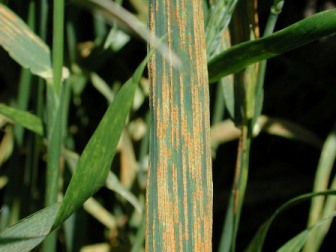Does Stripe Rust Follow the "Puccinia Pathway" to Manitoba?
Stripe rust, also known as yellow rust, is caused by a fungus Puccinia striiformis. It can affect wheat, barley and triticale. Generally, wheat is more susceptible than barley and triticale.
In Manitoba, stripe rust has been detected sporadically since 2000. To date, it has not caused serious yield losses. Stripe rust is favored by a cooler growing season than is common in Manitoba.
What is the risk of infection?
In Manitoba, most rust diseases do not overwinter. Instead, the sources of new infections (uredospores) are blown in on the “Puccinia Pathway” from the United States. Normally the first inoculum starts arriving at the beginning of June. However, this can vary depending on how much rust is present on cereal crops in the United States and when the winds blow from the south.
Often this migration of spores occurs during rainstorm events that draw air from the south. Uredospores are then deposited by rainfall here in Manitoba. During the growing season, reports on the current rust development is progressing in the United States are available in the Cereal Rust Bulletins from the United States Department of Agriculture (USDA).
When innoculum is present and favourable weather conditions occur,the potential for stripe rust to develop in Manitoba is significant since varieties grown in Manitoba are generally susceptible, with some exceptions. Producers should start scouting their winter and spring wheat crops for symptoms of stripe rust prior to flag leaf emergence.
Disease cycle and symptoms
Symptoms will normally appear about one week after infection. The uredospores need several hours of free moisture on plant leaves and temperatures near 10°C to germinate and infect the host.
After infection, tiny yelloish pustules (uredinia) appear in linear rows along the length of the leaf blade parallel with the leaf veins (see figures).
A single infection can result in one stripe the length of the leaf. The head can also be infected and kernels are replaced with yellow spores. With severe early infections, plants can also be stunted.
The yellow stripes consist of rust pustules, which are produced from eight days to two weeks after infection. These contain numerous uredospores, ready to be dispersed causing further infections.


Photos by: Dr. Brent McCallum, Agriculture and Agri-Food Canada
During the growing season, several crops of uredospores can be reproduced and continue to infect newly emerged leaves. Consequently, severe infections can progress from the middle to upper parts of the plant canopy resulting in yield reductions.
A single stripe rust infection on the leaf can take out the whole leaf without the need for another dew period. The fungus can grow within the leaves, unlike leaf or stem rust. Grain yield reduction is caused by the loss of photosynthetic green leaf area.
Stripe Rust Management
There are three main control methods:
- seeding spring varieties early
- growing resistant varieties
- applying foliar fungicides, when warranted
When warranted by favourable weather conditions, inoculum pressure and strong yield potential, a foliar fungicide needs to be applied preventatively before the disease is well-established in the crop. If disease severity has progressed beyond 30% of the leaf tissue being infected, it is probably to late to save the crop
There are numerous products available for the control of stripe rust. Refer to the Guide to Field Crop Protection for the most recent recommendations on the use of fungicides and a current list of registered fungicides. Always refer to product labels as they outline the crop and crop stage for application, recommended application rates, tank mix options, possible effects of weather, and restrictions (number of applications allowed per season, re-entry, re-cropping, pre-harvest interval, etc.).
What about stem or leaf rusts?
Like stripe rust, leaf and stem rusts overwinters in the United States and are blown into Manitoba by southerly winds. In the past, leaf rust in wheat has been more common in Manitoba than stem rust.
When scouting, look for small, round, bright orange-red pustules on the upper surface of leaves and sheaths. As the plant matures, the pustules will darken and may appear black. Later in the season as the weather warms up, stripe rust infection becomes less of concern while leaf rust risk increases.
Sources
- Cereal Rust Risk Reports – Prairie Crop Disease Monitoring Network Blog.
Wheat Stripe Rust. United States Department of Agriculture, Agricultural Research Service
- Dr. Tom Fetch – Pathologist, Agriculture and Agri-Food Canada, Morden, MB.
- Dr. Brent McCallum – Pathologist, Agriculture and Agri-Food Canada, Morden, MB.

